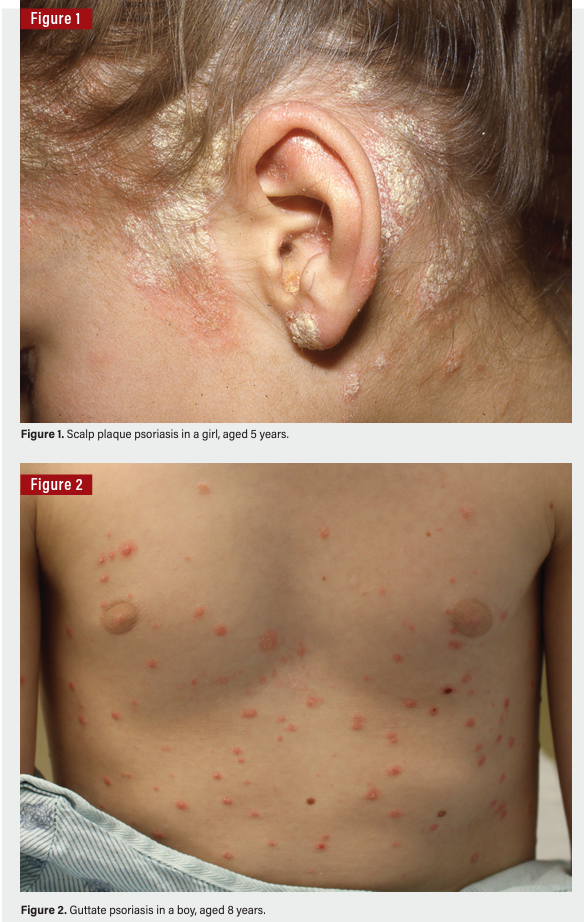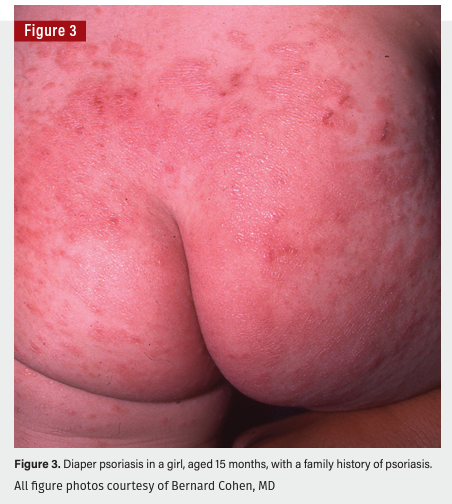- Case-Based Roundtable
- General Dermatology
- Eczema
- Chronic Hand Eczema
- Alopecia
- Aesthetics
- Vitiligo
- COVID-19
- Actinic Keratosis
- Precision Medicine and Biologics
- Rare Disease
- Wound Care
- Rosacea
- Psoriasis
- Psoriatic Arthritis
- Atopic Dermatitis
- Melasma
- NP and PA
- Skin Cancer
- Hidradenitis Suppurativa
- Drug Watch
- Pigmentary Disorders
- Acne
- Pediatric Dermatology
- Practice Management
- Prurigo Nodularis
- Buy-and-Bill
Publication
Article
Dermatology Times
An Overview of Pediatric Psoriasis
Author(s):
In one-third of cases of psoriasis, disease onset occurs in the first or second decade of life, although it may not be diagnosed until the patient has reached adulthood.
Psoriasis is a common, chronic, immune-mediated, multisystem, inflammatory disorder that affects all age groups, including infants and children.1-5 In one-third of cases, disease onset occurs in the first or second decade of life, although it may not be diagnosed until the patient has reached adulthood.2,3,6 Psoriasis primarily affects the skin1,5 but is associated with several medical comorbidities.6
In the pediatric population, psoriasis can have a strong negative impact on quality of life, social relationships, and school performance.2-6 Early diagnosis and treatment may substantially lessen the impact on children’s quality of life and comorbidities.2,6
Epidemiology
Psoriasis is a relatively common condition, affecting between 1% and 3% of the population worldwide (2%-4% of the European and North American populations), and its incidence keeps increasing.2,6 The mean age of onset in pediatric patients is between 8 and 11 years,5,6 with an increase in incidence in the second decade of life.6 White children are more affected compared with those of other ethnicities, and their mean age of onset is lower.6
There is a correlation between latitude and incidence of the disease, increasing with the distance from the equator.6 Additionally, positive family history of psoriasis in pediatric patients is frequently reported, with about 30% of the patients having an affected first-degree relative.1,2,6
Pathogenesis
Psoriasis is the result of polygenic predisposition and environmental triggers.1,5 The pathogenesis of psoriasis is based on chronic inflammation, increased keratinocyte proliferation, and dysfunctional differentiation.1 Although the main changes in psoriasis are found in the most superficial layer of the skin formed by keratinocytes, the psoriatic plaque is not limited to inflammation of the epidermis.1 It is characterized by the interaction between keratinocytes and many different cells, extending to the dermal layer of the skin.1
HLA-Cw6 is the most important susceptibility allele in psoriasis, localized in the susceptibility locus 1, also known as PSORS1.1,3,5,6 Considering this, some clinicians categorize psoriasis into 2 types: Type I, distinguished by early onset, positive family history, and the presence of HLA-Cw6; and type II, marked by late onset, no family history, and no expression of HLA-Cw6.1 The pathogenesis of psoriasis can be divided into an initiation phase—possibly caused by trauma, infections, or drugs—and a chronic phase, which involves long-term clinical progression. The main trigger factors in children include stress and infections, especially streptococcal infections.1,3,5,6
History and Symptoms
The history and symptoms of psoriasis can differ according to the child’s age and the psoriasis type.1 Most commonly, psoriasis lesions are found on the extremities (60%) and scalp (47%).1 Pruritus is the most common clinical manifestation.1 (Figure 1) Infants may present with a chronic diaper rash that persists despite many treatments.1,2 Adolescents have the same clinical features as adults do.1 Some children demonstrate the Koebner phenomenon, which is the appearance of new skin lesions on previously unaffected skin secondary to trauma.1,2,5,6 Psoriasis is characterized by erythematous papules that merge to create well-demarcated plaques with irregular borders, covered by a silvery-white scale. If the scale is removed, pinpoint bleeding will result, known as the Auspitz sign.1,2
In children with pigmented skin (Fitzpatrick skin type V or VI), the erythematous component is less prominent, and plaques often appear violaceous or hyperpigmented.3 Children with psoriasis have more facial and flexural lesions (known as inverse psoriasis) than adults and the plaques are smaller and thinner compared with those of adults.1,2,3,5
The most common type of psoriasis in children is chronic plaque psoriasis1-3 (75% of children with psoriasis)1 followed by guttate psoriasis1,2,5 (15%-25%)1. (Figure 2) Diaper psoriasis is a common variant seen exclusively in infants.1 (Figure 3)

Chronic plaque psoriasis is most common on the extensor extremities, trunk, flexures, and face.1 Guttate psoriasis is characterized by the sudden onset of droplet papules with symmetrical disposal over the trunk, limbs, and face.1 These lesions may be preceded by streptococcal infection1 and resorb within 3 to 4 weeks, or they can persist and transform into severe psoriasis.1 Nail psoriasis is less frequent in children compared with adults but can be observed in approximately 40% of cases.1-3
The severity of skin disease is classified based on the affected body surface area (BSA)1,3: mild (lesions cover less than 5% BSA), moderate (5%-10% BSA), and severe (more than 10% BSA).1
Comorbidities
Children with psoriasis are twice as likely to have comorbidities as those without psoriasis.1 Psoriasis has been associated with type 1 diabetes, rheumatoid arthritis, Crohn disease, systemic lupus erythematosus, vitiligo, alopecia areata, eczema, and lichen planus.1 An association with atopic dermatitis is frequently seen.1 Children with psoriasis, especially boys, have higher rates of obesity than children without psoriasis.1 In addition, obese patients with psoriasis are more likely to have severe forms of psoriasis compared with psoriatic children of normal weight.1,2,5,6 Obesity, with its low-grade systemic inflammation state, is able to influence the pathogenesis and the development of psoriasis by generating a chronic pro-inflammatory state, sustaining the dermatosis.5 The major comorbidity is psoriatic arthritis (PsA)1; this can occur at any age, but onset is more common between 2 and 3 years and 9 to 12 years.1 This condition mostly affects finger and toe joints.1
Children and adolescents with psoriasis are reported to have an increased risk of hypertension, hyperlipidemia, and diabetes,2,3,5,6 probably due to high rates of metabolic syndrome.1,5 Low levels of high-density lipoprotein cholesterol and high concentrations of fasting glucose appear in the early stages of metabolic syndrome in children with psoriasis.1 In addition, obesity has shown to be a risk factor for psoriasis developmentin children.1,6
The concept of psoriatic march defines the sequence of severe psoriasis causing systemic inflammation, then insulin resistance and endothelial dysfunction leading to atherosclerosis, myocardial infarction, and cardiovascular comorbidities.3,5,6 Some ocular manifestations may also occur.1 Many patients are stigmatized by other children and recreational activity can be highly affected. This stigmatization can induce changes in behavior, depression, and anxiety.1 In addition, the association between psoriasis and obesity increases the risk of social isolation, withdrawal, depression, and anxiety.1 Pediatric patients with psoriasis, and their parents, should receive psychosocial support due to the major impact on quality of life.1

Treatment Options
Psoriasis therapy varies according to patient age, type of psoriasis, affected sites, and extent of disease.1,2,6 The goal of therapy is to control the disease rather than obtain complete clearance of lesions.3 Clinicians should encourage healthy lifestyle choices involving diet and physical activity in pediatric patients. Maintaining a healthy diet not only targets overweight and obese patients, but also enhances the efficacy of antipsoriatic treatment.5 Physical activity has been shown to lower the risk of psoriasis and have a beneficial effect on the natural course of the disease.5
The concept of proactive therapy mainly used in atopic dermatitis is also described in childhood psoriasis.3 Managing pediatric psoriasis sometimes requires a multidisciplinary approach with a dermatologist, pediatrician, and rheumatologist.1,5
Topical agents
Topical agents such as emollients, vitamin D analogues, and corticosteroids are the first choice of treatment for children with mild-to-moderate psoriasis.1-3 Vitamin D analogues, calcipotriene, and calcitriol inhibit the proliferation of keratinocytes1,5-6 and are safe to use.1 Corticosteroids reduce inflammation and proliferation of keratinocytes, scaling, and erythema.1,6 However, they may have local and systemic adverse effects (AEs),1,2 particularly if high-potency agents are used and applied tolarge areas.1
Second-line topical treatments include retinoids, tars, anthralin, and keratolytics. Tazarotene decreases inflammation and helps to restore normal epidermal proliferation and differentiation.1,6 Tars have antipruritic and antiproliferative effects.1 Anthralin is especially used on thick plaques or large involved areas.1 Phenol and saline solution can be used for scalp lesions.1
Phototherapy
Phototherapy with narrow-band ultraviolet B and psoralen plus ultraviolet A (PUVA) are alternative therapies for children with chronic plaque or guttate psoriasis1,3,5,6 who have an unsatisfactory response to topical treatment.1,2,6 However, AEs of phototherapy in children can include erythema, burning, hyperpigmentation, viral reactivation1, and—with long-term treatment with PUVA—risk of cutaneous carcinogenesis.1,6 Psoralen use should be avoided in children younger than 12 years.1,3,6 Adherence is problematic in children due to school activities and a prolonged periodof therapy.3
Systemic therapy
Systemic therapy is required in persistent moderate to severe disease.1 Methotrexate, the most common systemic medication used for psoriasis in children, requires folic acid supplementation and laboratory monitoring.1,2 The most serious AEs of methotrexate are bone marrow suppression, hepatic toxicity,5 and pulmonary toxicity.1,6 Other options may include cyclosporine and systemic retinoids. Cyclosporine is well tolerated in pediatric patients and has a quick effect on severe, pustular, and erythrodermic psoriasis,1,5 but it requires careful laboratory monitoring. Acitretin is the most commonly used systemic retinoidin children.3
Biological therapy
Biologic therapy is becoming much more commonly used in pediatric patients.1 The FDA has approved etanercept (a tumor necrosis factor [TNF]-α inhibitor) for patients 4 years and older and ustekinumab (an interleukin [IL]-12 and IL-23 antagonist) for patients 12 years and older; adalimumab (a TNF-α inhibitor) was approved in Europe for patients 4 years and older.1 Etanercept is the preferred biologic therapy for pediatric patients and it has proved to be effective for moderate-to-severe psoriasis.1,5 AEs include mild injection site reaction, increased risk of infections and cold-like illnesses, hepatitis B virus reactivation, and the possibility of weight gain.1 Adalimumab is more effective compared with other biologics in the treatment of PsA. Just like other TNF-α inhibitors, adalimumab has absolute contraindications to treatments such as tuberculosis and other severe infections.1 Ustekinumab targets the IL-12 and IL-23 axis and it is effective for psoriasis and PsA.1 When TNF inhibitors fail, ustekinumab, with a different mechanism of action, provides an alternative treatment,1 but it has a slow onset of action.1 Secukinumab has shown good efficacy and safety profile for treating pediatric patients younger than 1 year.3 Apremilast, a phosphodiesterase-4 inhibitor, has shown to be useful in moderate-to-severe plaque psoriasis in a few case series,3 but larger studies are required to establish its efficacy and safety profile in children.3,6
Treatment Adherence
Barriers to adherence in pediatric patients with dermatologic disorders, just as in adults, have been identified, such as inconvenience, time constraints, difficult/unclear instructions, and fear of AEs.4 All of these adherence barriers are thought to be even more significant among children and adolescents, due to the influence of factors related to age and developmental stage.4
As children move into adolescence, they seek more autonomy and may want more independence in selecting among the treatment options for their dermatologic disease.4 Adolescents also may need more support from caregivers/parents and medical providers in developing time management skills to accommodate their medical treatment regimens into their daily routine, as topical medications may be sticky or greasy, time-consuming to apply correctly, and may impact their involvement in activities after application.4
Family communication strategies and problem-solving skills to minimize conflict are important during this transfer of responsibility for the treatment regimen from parent to adolescent.4 Very useful for developing self-management skills over time can be a written action plan that includes a clear outline of the medical regimen, including the types of tasks, frequency and location of medication applications, and how to adjust the intensity of treatments utilized when dermatologic symptoms improve or worsen.4 Written treatment plans have been shown to improve adherence in atopic dermatitis and can be applied to the management of psoriasis.4 Health care providers also play a significant role in promoting treatment adherence.4 It is important to directly educate patients and families on the disease and management.3-5 Close medical follow-up is crucial, and it has been observed that treatment adherence increases around the time of office appointments.2,4
While frequent visits simply to enhance adherence are not sustainable over the long term, in the time when new adherence behaviors are being developed, follow-up within 2 to4 weeks can help to positively reward self-care while also offering the opportunity for early reeducation or barrier mitigation.4 Teledermatology, too, has been shown to enhance adherence, by facilitating home monitoring, empowering patients, and strengthening patient-physician collaboration.4
Adherence issues in children with psoriasis may be exacerbated by the characteristics of topical medications commonly used, the visible nature of the disorder on the skin, and the impact of stress on the severity of the disease.4 Medical providers must assume that barriers to adherence are present for every patient, and they should actively address them.4
Mia Dekel is a 4th-year medical student at Humanitas University in Milan, Italy, who is planning to become a pediatrician.
Bernard Cohen, MD, is a professor of pediatrics and dermatology at Johns Hopkins University School of Medicine.
References
- Branisteanu DE, Georgescu S, Lacramioara Serban I, et al. Management of psoriasis in children (review). Exp Ther Med. 2021;22(6):1429. doi:10.3892/etm.2021.10864
- Bronckers IMGJ, Paller AS, van Geel MJ, van de Kerkhof PCM, Seyger MMB. Psoriasis in children and adolescents: diagnosis, management and comorbidities. Paediatr Drugs. 2015;17(5):373-384. doi:10.1007/s40272-015-0137-1
- Dhar S, Srinivas SM. Psoriasis in pediatric age group. Indian J Dermatol. 2022;67(4):374-380. doi:10.4103/ijd.ijd_570_22
- Shah KN, Cortina S, Ernst MM, Kichler JC. Psoriasis in childhood: effective strategies to improve treatment adherence. Psoriasis (Auckl). 2015;5:43-54. doi:10.2147/PTT.S54090
- Megna M, Napolitano N, Balato A, et al. Psoriasis in children: a review. Curr Pediatr Rev. 2015;11(1):10-26. doi:10.2174/1573400511666150504125456
- Relvas M, Torres T. Pediatric psoriasis. Am J Clin Dermatol. 2017;18(6):797-811. doi:10.1007/s40257-017-0294-9






